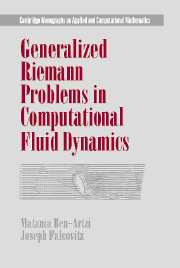Book contents
- Frontmatter
- Contents
- List of Figures
- Preface
- 1 Introduction
- I BASIC THEORY
- II NUMERICAL IMPLEMENTATION
- 7 From the GRP Algorithm to Scientific Computing
- 8 Geometric Extensions
- 9 A Physical Extension: Reacting Flow
- 10 Wave Interaction in a Duct — A Comparative Study
- A Entropy Conditions for Scalar Conservation Laws
- B Convergence of the Godunov Scheme
- C Riemann Solver for a γ-Law Gas
- D The MUSCL Scheme
- Bibliography
- Glossary
- Index
7 - From the GRP Algorithm to Scientific Computing
Published online by Cambridge University Press: 20 August 2009
- Frontmatter
- Contents
- List of Figures
- Preface
- 1 Introduction
- I BASIC THEORY
- II NUMERICAL IMPLEMENTATION
- 7 From the GRP Algorithm to Scientific Computing
- 8 Geometric Extensions
- 9 A Physical Extension: Reacting Flow
- 10 Wave Interaction in a Duct — A Comparative Study
- A Entropy Conditions for Scalar Conservation Laws
- B Convergence of the Godunov Scheme
- C Riemann Solver for a γ-Law Gas
- D The MUSCL Scheme
- Bibliography
- Glossary
- Index
Summary
The GRP algorithm was developed in Part I and tested against a variety of analytical examples. The next challenge is to adapt it to the needs of “Scientific Computing,” that is, to implement it in the simulation of problems of physical significance. This is a formidable task for any numerical algorithm. The problems encountered in applications usually are multidimensional and involve complex geometries and additional physical phenomena. In this chapter we first describe in more detail some of these problems, as a general background for the following chapters. We then proceed to the main goal of the chapter, namely, the upgrading of the GRP algorithm (which is essentially one dimensional) to a two-dimensional, second-order scheme. To this end we recall (Section 7.2) Strang's method of “operator splitting” and then (Section 7.3) apply it to the (planar) fluid-dynamical case. Although the method can be further extended to the three-dimensional case, we confine our presentation to the two-dimensional setup, which serves in our numerical examples (Chapters 8 and 10).
General Discussion
In Part I we studied the mathematical basis of the GRP method. We also considered a variety of numerical examples for which analytic (or at least asymptotic) solutions were available. This provided us with some measure of the accuracy of the computational results, and helped identifiy potential difficulties (such as the resolution of contact discontinuities).
- Type
- Chapter
- Information
- Generalized Riemann Problems in Computational Fluid Dynamics , pp. 235 - 250Publisher: Cambridge University PressPrint publication year: 2003

